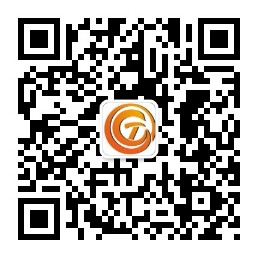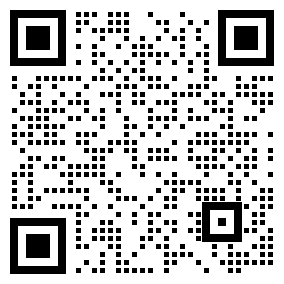In recent years, small devices that use battery power have developed rapidly, such as tablet computers, handheld game consoles, video players, digital photo frames, and so on. In general, these devices use rechargeable lithium-ion (Li-Ion) batteries as a power source. Some common charging solutions include wall adaptor class chargers and Universal Serial Bus (USB) class chargers. Although these charger solutions are a low-cost solution for charging lithium-ion batteries, these chargers also have a common disadvantage: they rely on the main power supply to operate. This dependence on the main power source increases the user's electricity bill and also increases greenhouse gas emissions. And because of their dependence on the main power supply, the portability of these charging solutions is also greatly reduced. To extend battery life in an environmentally friendly way, solar chargers that use solar panels to collect natural light energy may be an ideal solution. Another benefit of a solar charger is that it provides a mobile charging solution.
In this article, we will explain some important considerations when developing a solar charging solution. The main reason to consider these factors is that with the different lighting environment, the voltage and current also change, then the solar panel will become a high output impedance power supply. The wall power adapter or USB power supply is a low output impedance power supply with a pre-specified output voltage and current. The factors that need to be focused on in the solar charging solution we will discuss include: maximum power point tracking (MPPT), reverse leakage protection, charge termination method tips, and solar panel crash protection.
Maximum power point tracking
The maximum power point (MPP) is the working area of the solar cell where the maximum power can be obtained. The graph in Figure 1 shows this region. The graph shows the comparison of typical output current and output power with the voltage curve of the MPP two-section solar panel. The MPP on the curve is obvious because it is the voltage and current corresponding to the maximum power output of the solar panel. MPP is related to ambient temperature and light, so it changes over time. This shows that chargers using solar power must have the corresponding circuit to keep track of MPP as environmental conditions change. There are a wide range of MPPT solutions, including simple open-loop technologies (where the panel voltage is maintained at a fixed open-circuit voltage) and complex microcontroller-like technologies (where the input and output power is measured and then the panel voltage is properly regulated).
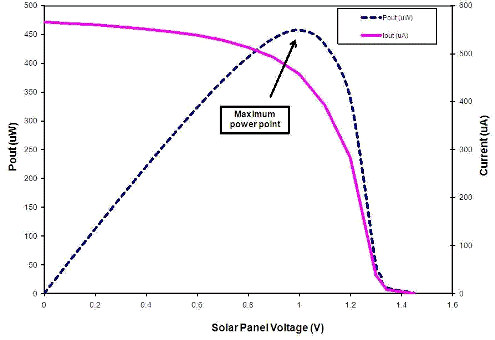
Reverse leakage protection
Reverse leakage is a phenomenon in which the charge stored in the battery is lost and returned to the power supply. Reverse leakage occurs when the battery voltage is higher than the power supply. When this phenomenon occurs, the power supply becomes the load of the battery and no longer charges the battery. This state does not occur when using a wall power adapter or USB power supply, because the voltage output of these two power supplies is always above the lithium-ion power supply voltage. When using solar panels, the voltage of the solar panels will be reduced to below the battery voltage in the case of insufficient light. Figure 2a shows a schematic diagram of a USB power charger connected to a battery. When switch S1 is off, the power supply is disconnected from the battery and there is no current in the battery. When using solar panels, if the same layout is used, the switch body diode is turned on if the solar panel voltage drops below the battery voltage. A common way to solve this problem is to use back-to-back switches, as shown in Figure 2b.
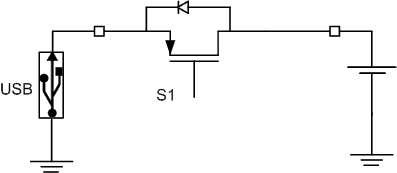
Termination of charge
Lithium-ion battery charging requires precise current and voltage control of the battery to ensure full battery charge, prevent shortened battery life, and prevent dangerous conditions during charging. The common process of charging a lithium-ion battery (see Figure 3) can be divided into three stages: pre-voltage regulation, constant current charging, and constant voltage charging.
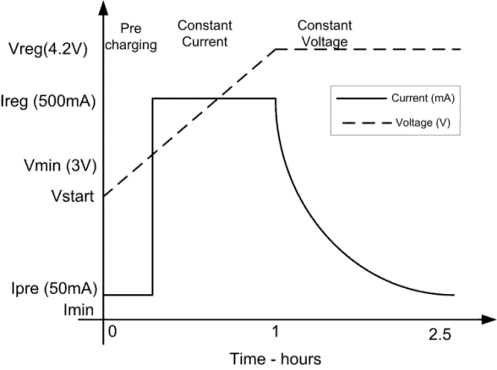
In the pre-voltage regulation stage, the battery is charged with a constant current of 0.1C (usually), so that the battery voltage slowly rises to about 2.5V. This stage is only used for deeply discharged batteries. Once the battery voltage rises above ~2.5V, it is charged using a constant current. In the constant current charging phase, the battery is charged with a constant current of 1C (usually) until the battery voltage reaches ~4.2V. Once the battery voltage reaches ~4.2V, the battery is charged using a constant voltage of 4.2V. At this stage, the current entering the battery needs to be monitored. When the battery current drops to 0.1C, the charging terminates. During the constant-voltage charging phase, the current entering the battery decreases because the battery impedance increases when the battery is full. Once the current is reduced below 0.1C, the charging source must be completely disconnected from the power supply. If it is not completely disconnected, there will be a metal lithium plating phenomenon, so that the battery becomes unstable, resulting in a dangerous state. We must terminate the charge of the lithium-ion battery according to the current entering the power supply to ensure that the battery is just full to its maximum charge.
Chargers that use solar power must follow the above charging process. Most of the problems occur during the constant-voltage charging phase, when the battery current is monitored. The current entering the battery may decrease, but not because of an increase in battery power, but because of a decrease in the output of the solar panel due to changes in the lighting environment. As a result, the battery may never be fully charged to its full capacity, and the solar panels may remain connected to the battery. To solve this problem, we can use a long constant timer. At the end of the time, the solar panel is disconnected from the charger, regardless of the battery level, which can prevent battery damage.
Solar panel crash protection
In some traditional chargers, we know the current and voltage of the power supply in advance. Therefore, the charger circuit is specially designed for operation within the specified range of the power supply. When using solar panel output, the current size and open circuit voltage are dynamic, depending on the surrounding environment. Therefore, it is more challenging to design a control loop for a solar charger than a wall power adapter.
The use of solar energy for lithium-ion battery charging system, while trying to maintain the lithium-ion battery charging process, but also can not let the solar panel accidental collapse phenomenon. Because if the solar panel voltage drops sharply, it can't get useful electricity from the solar panel. There is a greater probability of solar panel collapse during the constant current charging phase. At this stage, the solar panels may not be able to provide the current needed to charge the battery. When this happens, the solar panel voltage begins to collapse rapidly. Therefore, the charger must be able to detect a rapid drop in the solar panel voltage and immediately reduce the amount of current drawn from the solar panel, thereby preventing the solar panel from collapsing.
Sum up
Solar chargers can provide a mobile, environmentally friendly way to charge lithium-ion batteries. When designing a solar charger, you will encounter many problems that are not encountered when designing a wall power adapter charger. If designers are smart, they can design chargers that can use solar power, USB and wall power adapter input to achieve the perfect charge of lithium-ion batteries.
免责声明: 本文章转自其它平台,并不代表本站观点及立场。若有侵权或异议,请联系我们删除。谢谢! Disclaimer: This article is reproduced from other platforms and does not represent the views or positions of this website. If there is any infringement or objection, please contact us to delete it. thank you! |

